Analyzing Cadbury's Production Process Through Market Research Project
VerifiedAdded on 2020/03/16
|15
|4657
|325
Project
AI Summary
This research report examines the relationship between production processes and market research, using Cadbury's as a case study. The primary aim is to assess how effectively market research identifies risks in the production process and informs improvements in production management. The report begins with an introduction outlining the research's background, objectives, and research questions. A literature review explores production management, its components, and market research. The core of the report involves data analysis, leading to findings that address the research objectives. The report concludes with a discussion of research gaps and recommendations for future studies. The study emphasizes the importance of integrating market research to align production processes with customer demands and enhance customer satisfaction within the confectionery industry. The report delves into factors affecting production, suitable management techniques, and the effectiveness of market research in providing insights for change within Cadbury's.
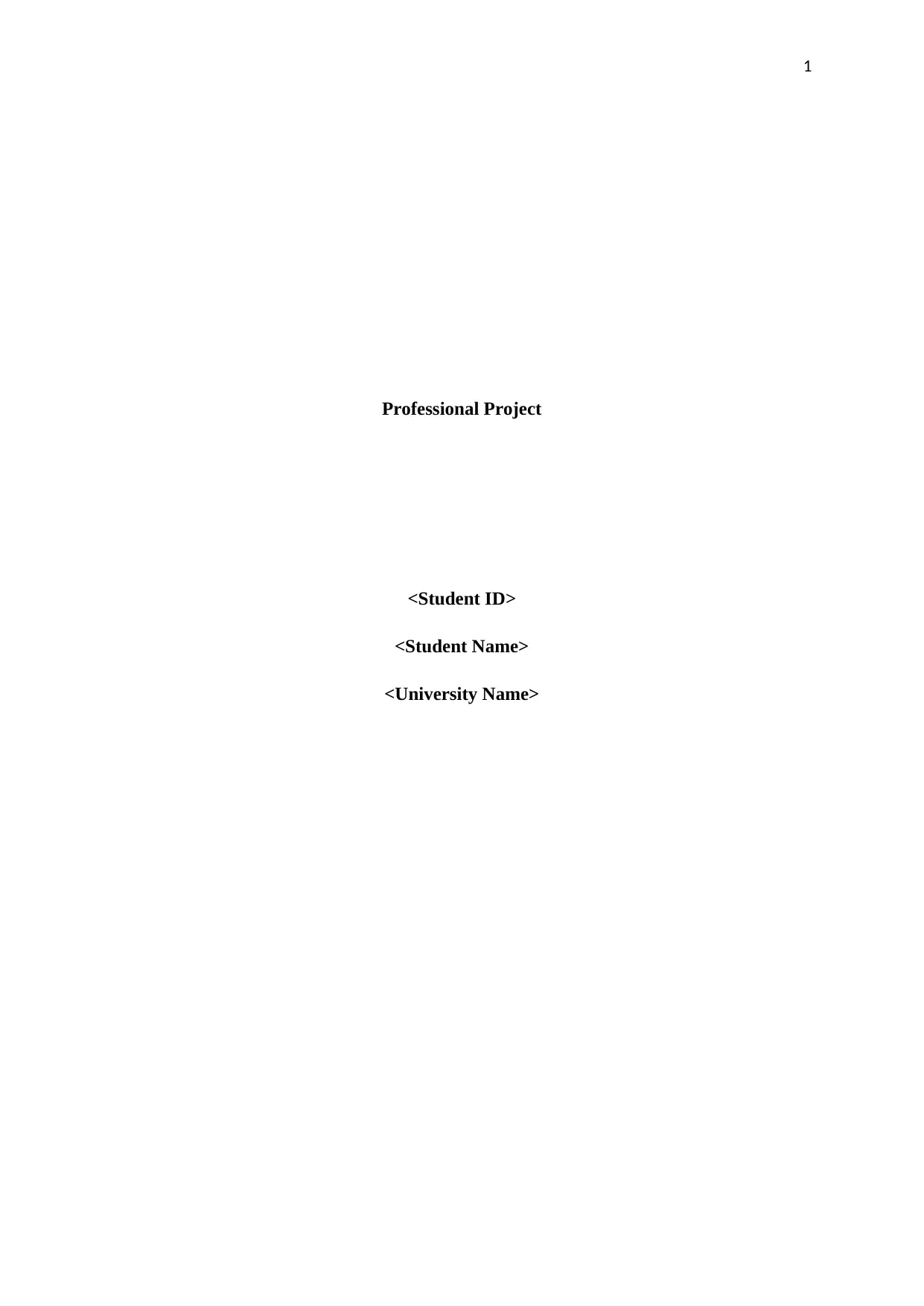
1
Professional Project
<Student ID>
<Student Name>
<University Name>
Professional Project
<Student ID>
<Student Name>
<University Name>
Secure Best Marks with AI Grader
Need help grading? Try our AI Grader for instant feedback on your assignments.
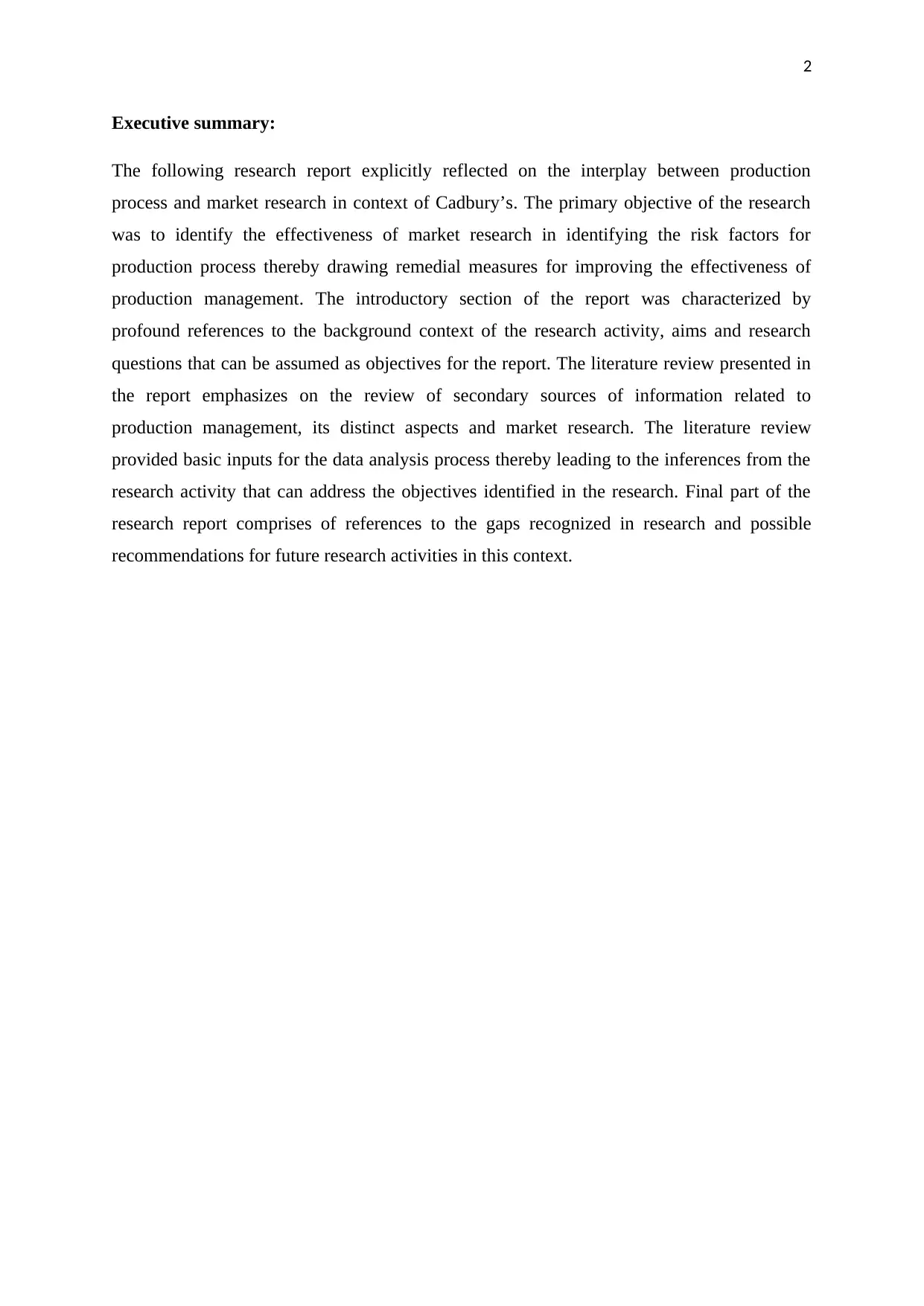
2
Executive summary:
The following research report explicitly reflected on the interplay between production
process and market research in context of Cadbury’s. The primary objective of the research
was to identify the effectiveness of market research in identifying the risk factors for
production process thereby drawing remedial measures for improving the effectiveness of
production management. The introductory section of the report was characterized by
profound references to the background context of the research activity, aims and research
questions that can be assumed as objectives for the report. The literature review presented in
the report emphasizes on the review of secondary sources of information related to
production management, its distinct aspects and market research. The literature review
provided basic inputs for the data analysis process thereby leading to the inferences from the
research activity that can address the objectives identified in the research. Final part of the
research report comprises of references to the gaps recognized in research and possible
recommendations for future research activities in this context.
Executive summary:
The following research report explicitly reflected on the interplay between production
process and market research in context of Cadbury’s. The primary objective of the research
was to identify the effectiveness of market research in identifying the risk factors for
production process thereby drawing remedial measures for improving the effectiveness of
production management. The introductory section of the report was characterized by
profound references to the background context of the research activity, aims and research
questions that can be assumed as objectives for the report. The literature review presented in
the report emphasizes on the review of secondary sources of information related to
production management, its distinct aspects and market research. The literature review
provided basic inputs for the data analysis process thereby leading to the inferences from the
research activity that can address the objectives identified in the research. Final part of the
research report comprises of references to the gaps recognized in research and possible
recommendations for future research activities in this context.
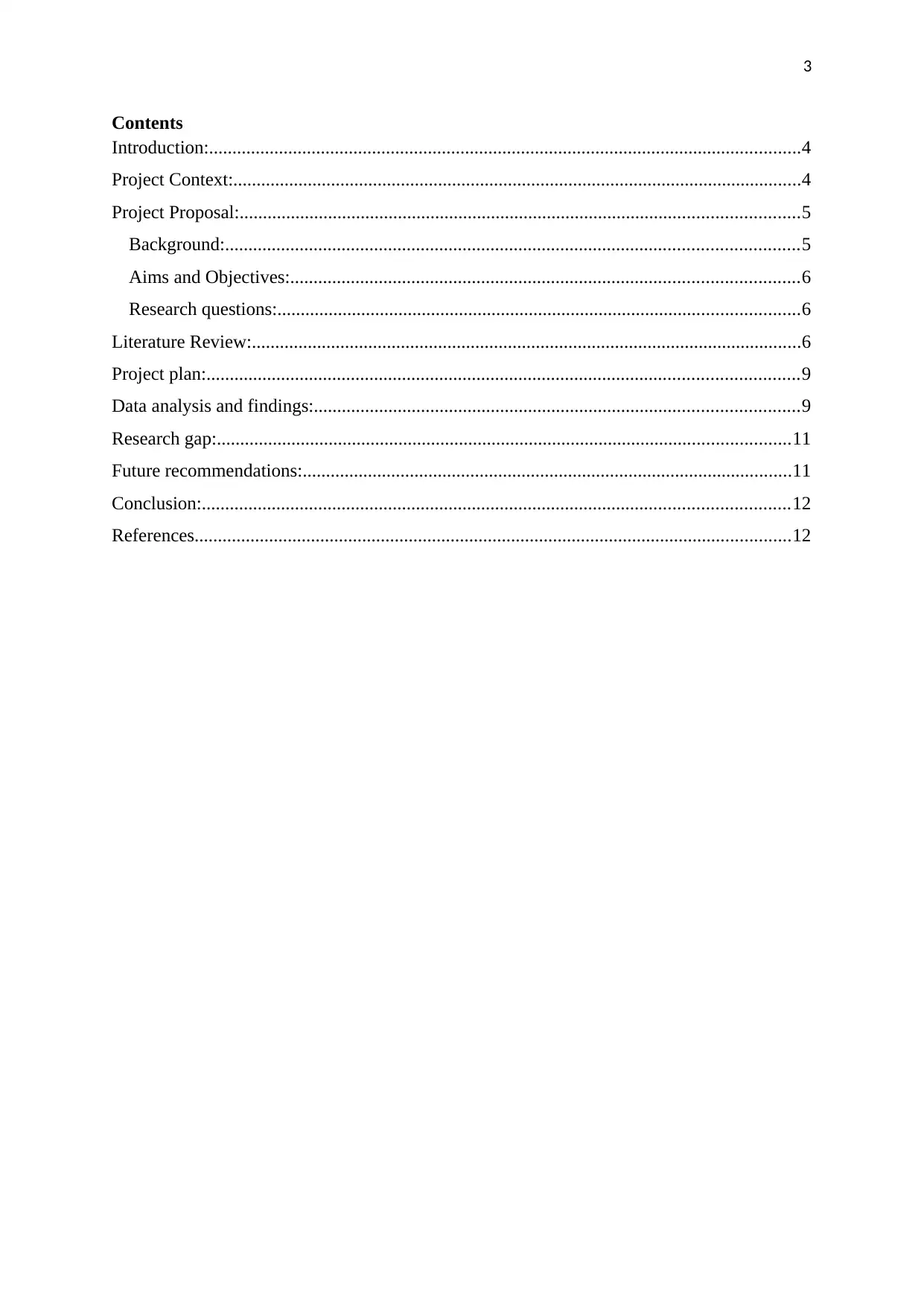
3
Contents
Introduction:...............................................................................................................................4
Project Context:..........................................................................................................................4
Project Proposal:........................................................................................................................5
Background:...........................................................................................................................5
Aims and Objectives:.............................................................................................................6
Research questions:................................................................................................................6
Literature Review:......................................................................................................................6
Project plan:...............................................................................................................................9
Data analysis and findings:........................................................................................................9
Research gap:...........................................................................................................................11
Future recommendations:.........................................................................................................11
Conclusion:..............................................................................................................................12
References................................................................................................................................12
Contents
Introduction:...............................................................................................................................4
Project Context:..........................................................................................................................4
Project Proposal:........................................................................................................................5
Background:...........................................................................................................................5
Aims and Objectives:.............................................................................................................6
Research questions:................................................................................................................6
Literature Review:......................................................................................................................6
Project plan:...............................................................................................................................9
Data analysis and findings:........................................................................................................9
Research gap:...........................................................................................................................11
Future recommendations:.........................................................................................................11
Conclusion:..............................................................................................................................12
References................................................................................................................................12
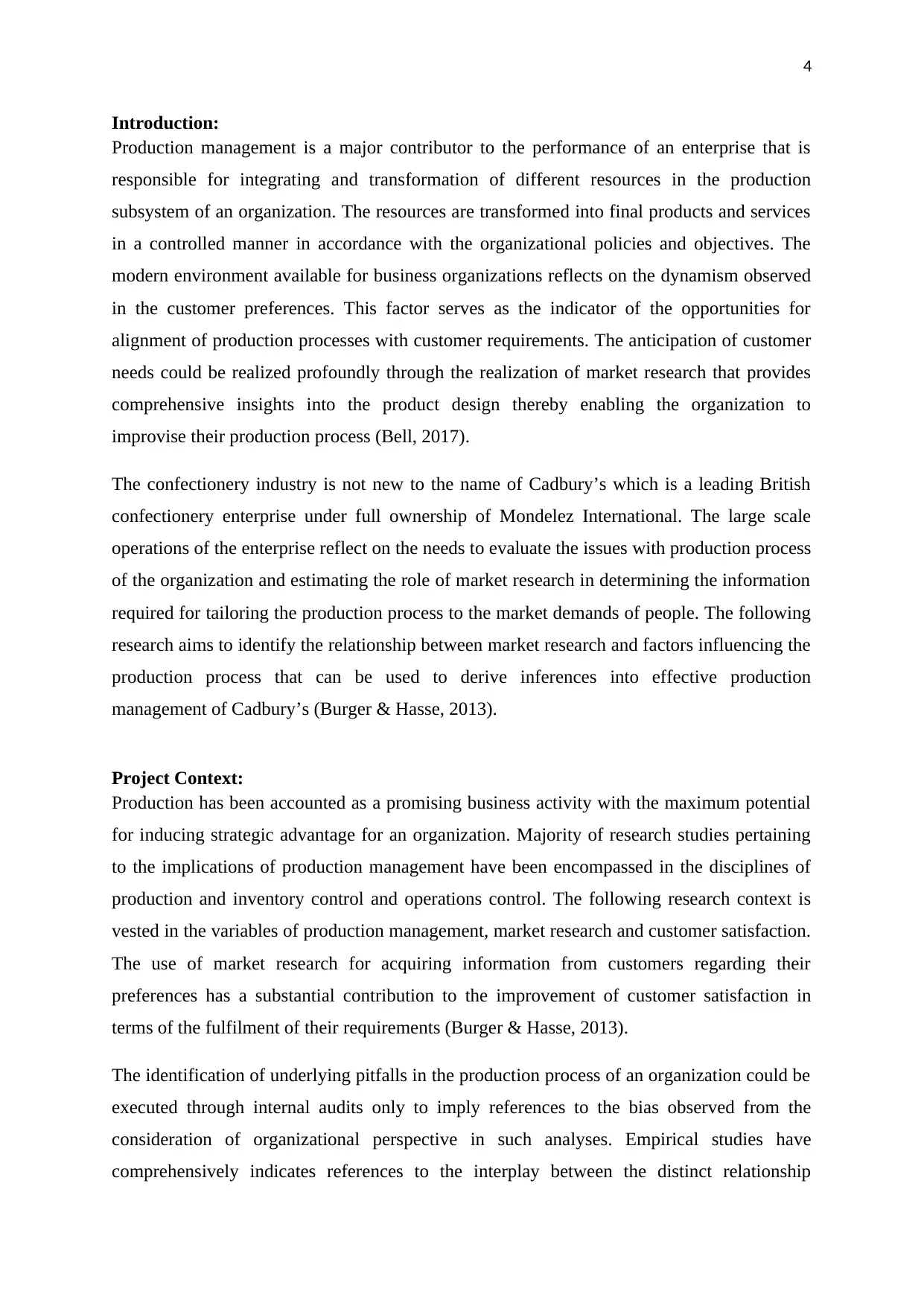
4
Introduction:
Production management is a major contributor to the performance of an enterprise that is
responsible for integrating and transformation of different resources in the production
subsystem of an organization. The resources are transformed into final products and services
in a controlled manner in accordance with the organizational policies and objectives. The
modern environment available for business organizations reflects on the dynamism observed
in the customer preferences. This factor serves as the indicator of the opportunities for
alignment of production processes with customer requirements. The anticipation of customer
needs could be realized profoundly through the realization of market research that provides
comprehensive insights into the product design thereby enabling the organization to
improvise their production process (Bell, 2017).
The confectionery industry is not new to the name of Cadbury’s which is a leading British
confectionery enterprise under full ownership of Mondelez International. The large scale
operations of the enterprise reflect on the needs to evaluate the issues with production process
of the organization and estimating the role of market research in determining the information
required for tailoring the production process to the market demands of people. The following
research aims to identify the relationship between market research and factors influencing the
production process that can be used to derive inferences into effective production
management of Cadbury’s (Burger & Hasse, 2013).
Project Context:
Production has been accounted as a promising business activity with the maximum potential
for inducing strategic advantage for an organization. Majority of research studies pertaining
to the implications of production management have been encompassed in the disciplines of
production and inventory control and operations control. The following research context is
vested in the variables of production management, market research and customer satisfaction.
The use of market research for acquiring information from customers regarding their
preferences has a substantial contribution to the improvement of customer satisfaction in
terms of the fulfilment of their requirements (Burger & Hasse, 2013).
The identification of underlying pitfalls in the production process of an organization could be
executed through internal audits only to imply references to the bias observed from the
consideration of organizational perspective in such analyses. Empirical studies have
comprehensively indicates references to the interplay between the distinct relationship
Introduction:
Production management is a major contributor to the performance of an enterprise that is
responsible for integrating and transformation of different resources in the production
subsystem of an organization. The resources are transformed into final products and services
in a controlled manner in accordance with the organizational policies and objectives. The
modern environment available for business organizations reflects on the dynamism observed
in the customer preferences. This factor serves as the indicator of the opportunities for
alignment of production processes with customer requirements. The anticipation of customer
needs could be realized profoundly through the realization of market research that provides
comprehensive insights into the product design thereby enabling the organization to
improvise their production process (Bell, 2017).
The confectionery industry is not new to the name of Cadbury’s which is a leading British
confectionery enterprise under full ownership of Mondelez International. The large scale
operations of the enterprise reflect on the needs to evaluate the issues with production process
of the organization and estimating the role of market research in determining the information
required for tailoring the production process to the market demands of people. The following
research aims to identify the relationship between market research and factors influencing the
production process that can be used to derive inferences into effective production
management of Cadbury’s (Burger & Hasse, 2013).
Project Context:
Production has been accounted as a promising business activity with the maximum potential
for inducing strategic advantage for an organization. Majority of research studies pertaining
to the implications of production management have been encompassed in the disciplines of
production and inventory control and operations control. The following research context is
vested in the variables of production management, market research and customer satisfaction.
The use of market research for acquiring information from customers regarding their
preferences has a substantial contribution to the improvement of customer satisfaction in
terms of the fulfilment of their requirements (Burger & Hasse, 2013).
The identification of underlying pitfalls in the production process of an organization could be
executed through internal audits only to imply references to the bias observed from the
consideration of organizational perspective in such analyses. Empirical studies have
comprehensively indicates references to the interplay between the distinct relationship
Secure Best Marks with AI Grader
Need help grading? Try our AI Grader for instant feedback on your assignments.
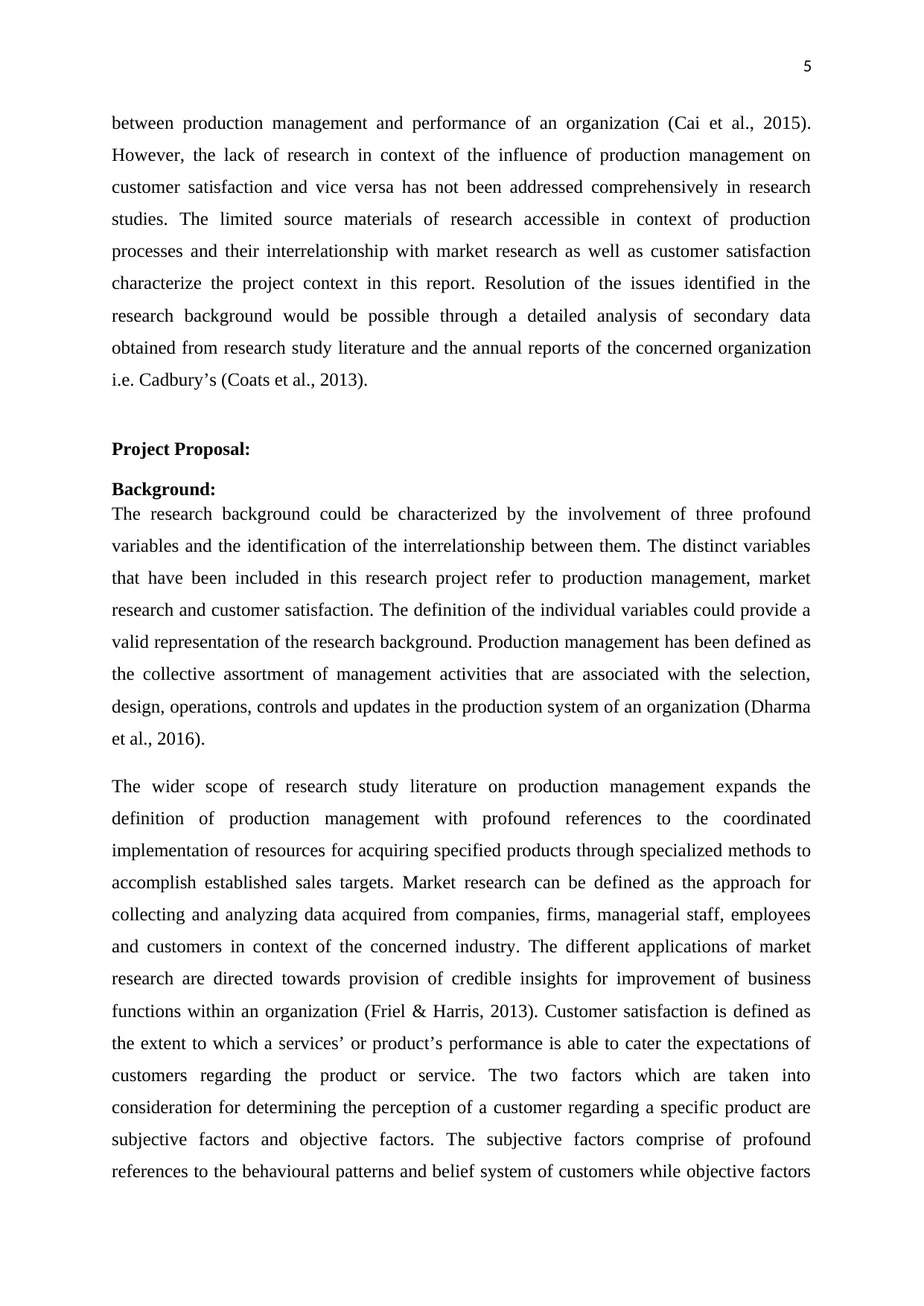
5
between production management and performance of an organization (Cai et al., 2015).
However, the lack of research in context of the influence of production management on
customer satisfaction and vice versa has not been addressed comprehensively in research
studies. The limited source materials of research accessible in context of production
processes and their interrelationship with market research as well as customer satisfaction
characterize the project context in this report. Resolution of the issues identified in the
research background would be possible through a detailed analysis of secondary data
obtained from research study literature and the annual reports of the concerned organization
i.e. Cadbury’s (Coats et al., 2013).
Project Proposal:
Background:
The research background could be characterized by the involvement of three profound
variables and the identification of the interrelationship between them. The distinct variables
that have been included in this research project refer to production management, market
research and customer satisfaction. The definition of the individual variables could provide a
valid representation of the research background. Production management has been defined as
the collective assortment of management activities that are associated with the selection,
design, operations, controls and updates in the production system of an organization (Dharma
et al., 2016).
The wider scope of research study literature on production management expands the
definition of production management with profound references to the coordinated
implementation of resources for acquiring specified products through specialized methods to
accomplish established sales targets. Market research can be defined as the approach for
collecting and analyzing data acquired from companies, firms, managerial staff, employees
and customers in context of the concerned industry. The different applications of market
research are directed towards provision of credible insights for improvement of business
functions within an organization (Friel & Harris, 2013). Customer satisfaction is defined as
the extent to which a services’ or product’s performance is able to cater the expectations of
customers regarding the product or service. The two factors which are taken into
consideration for determining the perception of a customer regarding a specific product are
subjective factors and objective factors. The subjective factors comprise of profound
references to the behavioural patterns and belief system of customers while objective factors
between production management and performance of an organization (Cai et al., 2015).
However, the lack of research in context of the influence of production management on
customer satisfaction and vice versa has not been addressed comprehensively in research
studies. The limited source materials of research accessible in context of production
processes and their interrelationship with market research as well as customer satisfaction
characterize the project context in this report. Resolution of the issues identified in the
research background would be possible through a detailed analysis of secondary data
obtained from research study literature and the annual reports of the concerned organization
i.e. Cadbury’s (Coats et al., 2013).
Project Proposal:
Background:
The research background could be characterized by the involvement of three profound
variables and the identification of the interrelationship between them. The distinct variables
that have been included in this research project refer to production management, market
research and customer satisfaction. The definition of the individual variables could provide a
valid representation of the research background. Production management has been defined as
the collective assortment of management activities that are associated with the selection,
design, operations, controls and updates in the production system of an organization (Dharma
et al., 2016).
The wider scope of research study literature on production management expands the
definition of production management with profound references to the coordinated
implementation of resources for acquiring specified products through specialized methods to
accomplish established sales targets. Market research can be defined as the approach for
collecting and analyzing data acquired from companies, firms, managerial staff, employees
and customers in context of the concerned industry. The different applications of market
research are directed towards provision of credible insights for improvement of business
functions within an organization (Friel & Harris, 2013). Customer satisfaction is defined as
the extent to which a services’ or product’s performance is able to cater the expectations of
customers regarding the product or service. The two factors which are taken into
consideration for determining the perception of a customer regarding a specific product are
subjective factors and objective factors. The subjective factors comprise of profound
references to the behavioural patterns and belief system of customers while objective factors
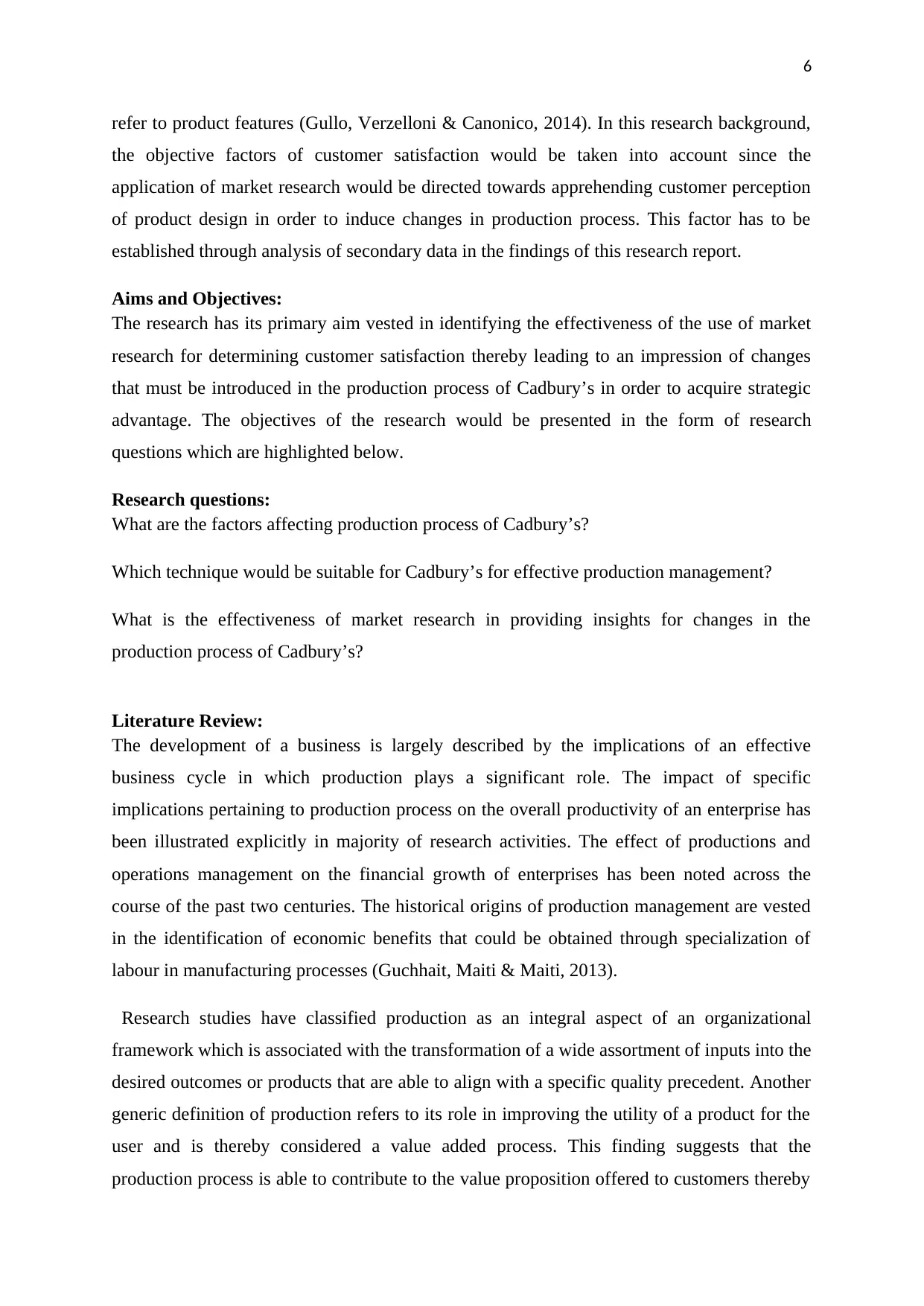
6
refer to product features (Gullo, Verzelloni & Canonico, 2014). In this research background,
the objective factors of customer satisfaction would be taken into account since the
application of market research would be directed towards apprehending customer perception
of product design in order to induce changes in production process. This factor has to be
established through analysis of secondary data in the findings of this research report.
Aims and Objectives:
The research has its primary aim vested in identifying the effectiveness of the use of market
research for determining customer satisfaction thereby leading to an impression of changes
that must be introduced in the production process of Cadbury’s in order to acquire strategic
advantage. The objectives of the research would be presented in the form of research
questions which are highlighted below.
Research questions:
What are the factors affecting production process of Cadbury’s?
Which technique would be suitable for Cadbury’s for effective production management?
What is the effectiveness of market research in providing insights for changes in the
production process of Cadbury’s?
Literature Review:
The development of a business is largely described by the implications of an effective
business cycle in which production plays a significant role. The impact of specific
implications pertaining to production process on the overall productivity of an enterprise has
been illustrated explicitly in majority of research activities. The effect of productions and
operations management on the financial growth of enterprises has been noted across the
course of the past two centuries. The historical origins of production management are vested
in the identification of economic benefits that could be obtained through specialization of
labour in manufacturing processes (Guchhait, Maiti & Maiti, 2013).
Research studies have classified production as an integral aspect of an organizational
framework which is associated with the transformation of a wide assortment of inputs into the
desired outcomes or products that are able to align with a specific quality precedent. Another
generic definition of production refers to its role in improving the utility of a product for the
user and is thereby considered a value added process. This finding suggests that the
production process is able to contribute to the value proposition offered to customers thereby
refer to product features (Gullo, Verzelloni & Canonico, 2014). In this research background,
the objective factors of customer satisfaction would be taken into account since the
application of market research would be directed towards apprehending customer perception
of product design in order to induce changes in production process. This factor has to be
established through analysis of secondary data in the findings of this research report.
Aims and Objectives:
The research has its primary aim vested in identifying the effectiveness of the use of market
research for determining customer satisfaction thereby leading to an impression of changes
that must be introduced in the production process of Cadbury’s in order to acquire strategic
advantage. The objectives of the research would be presented in the form of research
questions which are highlighted below.
Research questions:
What are the factors affecting production process of Cadbury’s?
Which technique would be suitable for Cadbury’s for effective production management?
What is the effectiveness of market research in providing insights for changes in the
production process of Cadbury’s?
Literature Review:
The development of a business is largely described by the implications of an effective
business cycle in which production plays a significant role. The impact of specific
implications pertaining to production process on the overall productivity of an enterprise has
been illustrated explicitly in majority of research activities. The effect of productions and
operations management on the financial growth of enterprises has been noted across the
course of the past two centuries. The historical origins of production management are vested
in the identification of economic benefits that could be obtained through specialization of
labour in manufacturing processes (Guchhait, Maiti & Maiti, 2013).
Research studies have classified production as an integral aspect of an organizational
framework which is associated with the transformation of a wide assortment of inputs into the
desired outcomes or products that are able to align with a specific quality precedent. Another
generic definition of production refers to its role in improving the utility of a product for the
user and is thereby considered a value added process. This finding suggests that the
production process is able to contribute to the value proposition offered to customers thereby
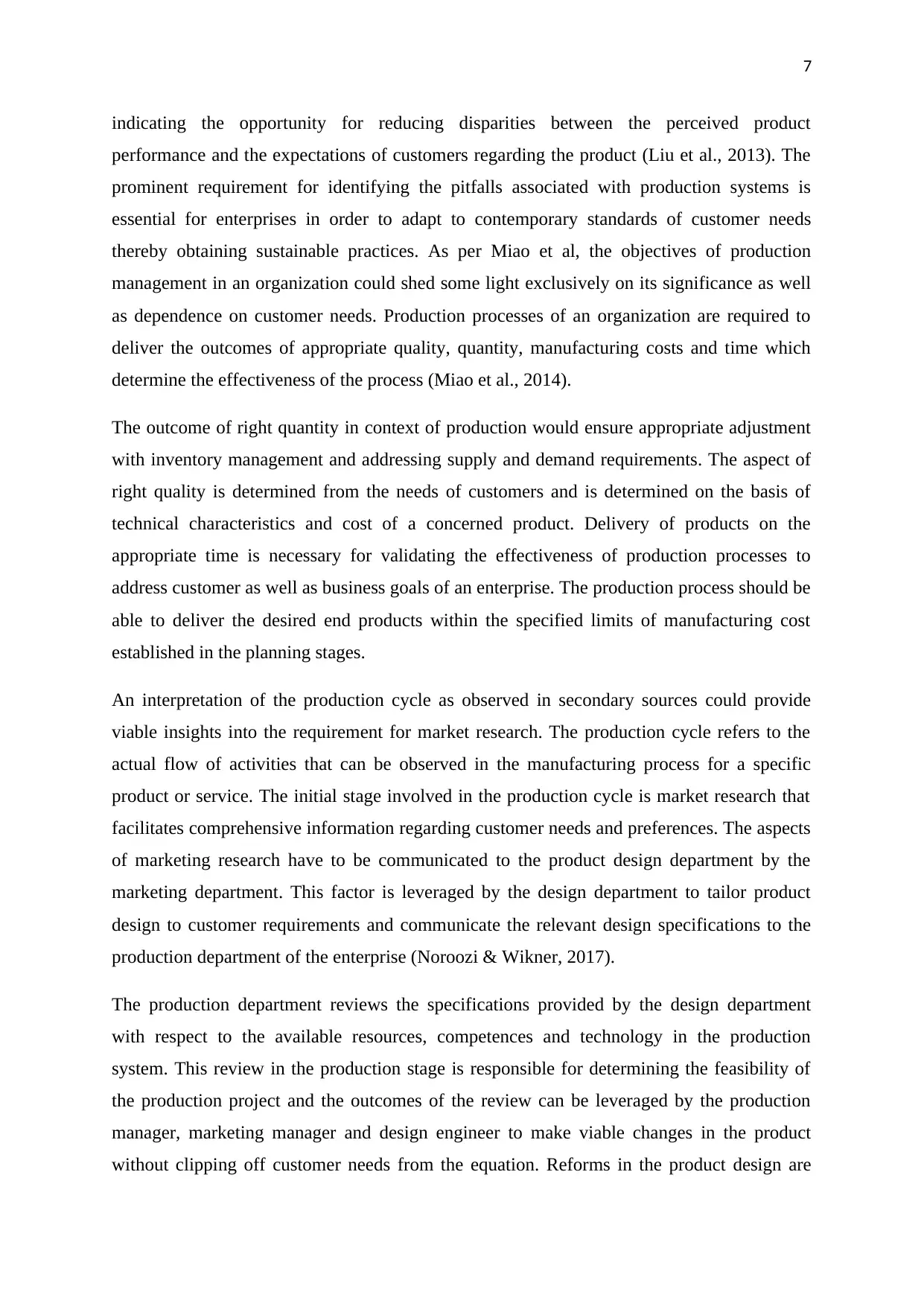
7
indicating the opportunity for reducing disparities between the perceived product
performance and the expectations of customers regarding the product (Liu et al., 2013). The
prominent requirement for identifying the pitfalls associated with production systems is
essential for enterprises in order to adapt to contemporary standards of customer needs
thereby obtaining sustainable practices. As per Miao et al, the objectives of production
management in an organization could shed some light exclusively on its significance as well
as dependence on customer needs. Production processes of an organization are required to
deliver the outcomes of appropriate quality, quantity, manufacturing costs and time which
determine the effectiveness of the process (Miao et al., 2014).
The outcome of right quantity in context of production would ensure appropriate adjustment
with inventory management and addressing supply and demand requirements. The aspect of
right quality is determined from the needs of customers and is determined on the basis of
technical characteristics and cost of a concerned product. Delivery of products on the
appropriate time is necessary for validating the effectiveness of production processes to
address customer as well as business goals of an enterprise. The production process should be
able to deliver the desired end products within the specified limits of manufacturing cost
established in the planning stages.
An interpretation of the production cycle as observed in secondary sources could provide
viable insights into the requirement for market research. The production cycle refers to the
actual flow of activities that can be observed in the manufacturing process for a specific
product or service. The initial stage involved in the production cycle is market research that
facilitates comprehensive information regarding customer needs and preferences. The aspects
of marketing research have to be communicated to the product design department by the
marketing department. This factor is leveraged by the design department to tailor product
design to customer requirements and communicate the relevant design specifications to the
production department of the enterprise (Noroozi & Wikner, 2017).
The production department reviews the specifications provided by the design department
with respect to the available resources, competences and technology in the production
system. This review in the production stage is responsible for determining the feasibility of
the production project and the outcomes of the review can be leveraged by the production
manager, marketing manager and design engineer to make viable changes in the product
without clipping off customer needs from the equation. Reforms in the product design are
indicating the opportunity for reducing disparities between the perceived product
performance and the expectations of customers regarding the product (Liu et al., 2013). The
prominent requirement for identifying the pitfalls associated with production systems is
essential for enterprises in order to adapt to contemporary standards of customer needs
thereby obtaining sustainable practices. As per Miao et al, the objectives of production
management in an organization could shed some light exclusively on its significance as well
as dependence on customer needs. Production processes of an organization are required to
deliver the outcomes of appropriate quality, quantity, manufacturing costs and time which
determine the effectiveness of the process (Miao et al., 2014).
The outcome of right quantity in context of production would ensure appropriate adjustment
with inventory management and addressing supply and demand requirements. The aspect of
right quality is determined from the needs of customers and is determined on the basis of
technical characteristics and cost of a concerned product. Delivery of products on the
appropriate time is necessary for validating the effectiveness of production processes to
address customer as well as business goals of an enterprise. The production process should be
able to deliver the desired end products within the specified limits of manufacturing cost
established in the planning stages.
An interpretation of the production cycle as observed in secondary sources could provide
viable insights into the requirement for market research. The production cycle refers to the
actual flow of activities that can be observed in the manufacturing process for a specific
product or service. The initial stage involved in the production cycle is market research that
facilitates comprehensive information regarding customer needs and preferences. The aspects
of marketing research have to be communicated to the product design department by the
marketing department. This factor is leveraged by the design department to tailor product
design to customer requirements and communicate the relevant design specifications to the
production department of the enterprise (Noroozi & Wikner, 2017).
The production department reviews the specifications provided by the design department
with respect to the available resources, competences and technology in the production
system. This review in the production stage is responsible for determining the feasibility of
the production project and the outcomes of the review can be leveraged by the production
manager, marketing manager and design engineer to make viable changes in the product
without clipping off customer needs from the equation. Reforms in the product design are
Paraphrase This Document
Need a fresh take? Get an instant paraphrase of this document with our AI Paraphraser
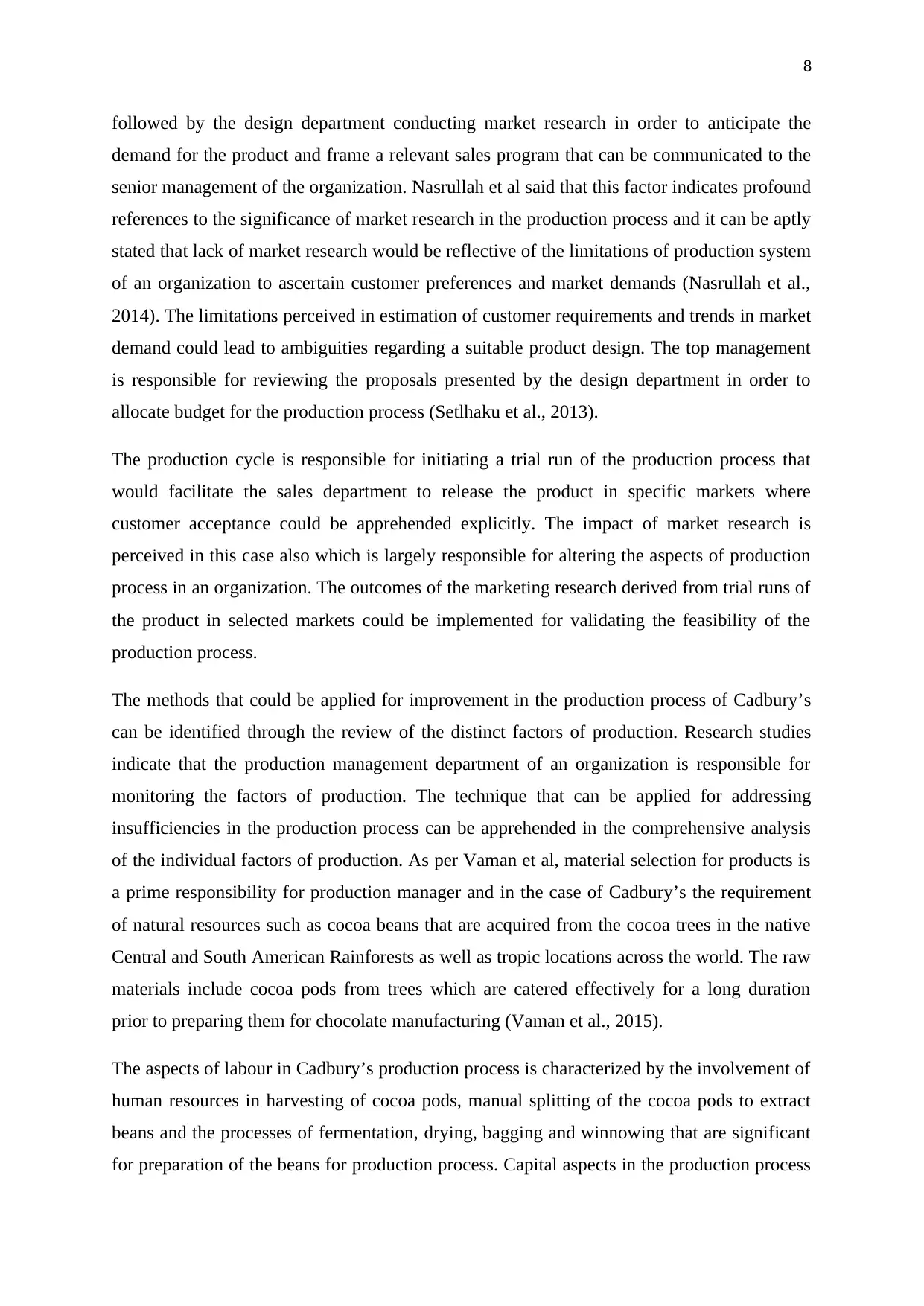
8
followed by the design department conducting market research in order to anticipate the
demand for the product and frame a relevant sales program that can be communicated to the
senior management of the organization. Nasrullah et al said that this factor indicates profound
references to the significance of market research in the production process and it can be aptly
stated that lack of market research would be reflective of the limitations of production system
of an organization to ascertain customer preferences and market demands (Nasrullah et al.,
2014). The limitations perceived in estimation of customer requirements and trends in market
demand could lead to ambiguities regarding a suitable product design. The top management
is responsible for reviewing the proposals presented by the design department in order to
allocate budget for the production process (Setlhaku et al., 2013).
The production cycle is responsible for initiating a trial run of the production process that
would facilitate the sales department to release the product in specific markets where
customer acceptance could be apprehended explicitly. The impact of market research is
perceived in this case also which is largely responsible for altering the aspects of production
process in an organization. The outcomes of the marketing research derived from trial runs of
the product in selected markets could be implemented for validating the feasibility of the
production process.
The methods that could be applied for improvement in the production process of Cadbury’s
can be identified through the review of the distinct factors of production. Research studies
indicate that the production management department of an organization is responsible for
monitoring the factors of production. The technique that can be applied for addressing
insufficiencies in the production process can be apprehended in the comprehensive analysis
of the individual factors of production. As per Vaman et al, material selection for products is
a prime responsibility for production manager and in the case of Cadbury’s the requirement
of natural resources such as cocoa beans that are acquired from the cocoa trees in the native
Central and South American Rainforests as well as tropic locations across the world. The raw
materials include cocoa pods from trees which are catered effectively for a long duration
prior to preparing them for chocolate manufacturing (Vaman et al., 2015).
The aspects of labour in Cadbury’s production process is characterized by the involvement of
human resources in harvesting of cocoa pods, manual splitting of the cocoa pods to extract
beans and the processes of fermentation, drying, bagging and winnowing that are significant
for preparation of the beans for production process. Capital aspects in the production process
followed by the design department conducting market research in order to anticipate the
demand for the product and frame a relevant sales program that can be communicated to the
senior management of the organization. Nasrullah et al said that this factor indicates profound
references to the significance of market research in the production process and it can be aptly
stated that lack of market research would be reflective of the limitations of production system
of an organization to ascertain customer preferences and market demands (Nasrullah et al.,
2014). The limitations perceived in estimation of customer requirements and trends in market
demand could lead to ambiguities regarding a suitable product design. The top management
is responsible for reviewing the proposals presented by the design department in order to
allocate budget for the production process (Setlhaku et al., 2013).
The production cycle is responsible for initiating a trial run of the production process that
would facilitate the sales department to release the product in specific markets where
customer acceptance could be apprehended explicitly. The impact of market research is
perceived in this case also which is largely responsible for altering the aspects of production
process in an organization. The outcomes of the marketing research derived from trial runs of
the product in selected markets could be implemented for validating the feasibility of the
production process.
The methods that could be applied for improvement in the production process of Cadbury’s
can be identified through the review of the distinct factors of production. Research studies
indicate that the production management department of an organization is responsible for
monitoring the factors of production. The technique that can be applied for addressing
insufficiencies in the production process can be apprehended in the comprehensive analysis
of the individual factors of production. As per Vaman et al, material selection for products is
a prime responsibility for production manager and in the case of Cadbury’s the requirement
of natural resources such as cocoa beans that are acquired from the cocoa trees in the native
Central and South American Rainforests as well as tropic locations across the world. The raw
materials include cocoa pods from trees which are catered effectively for a long duration
prior to preparing them for chocolate manufacturing (Vaman et al., 2015).
The aspects of labour in Cadbury’s production process is characterized by the involvement of
human resources in harvesting of cocoa pods, manual splitting of the cocoa pods to extract
beans and the processes of fermentation, drying, bagging and winnowing that are significant
for preparation of the beans for production process. Capital aspects in the production process
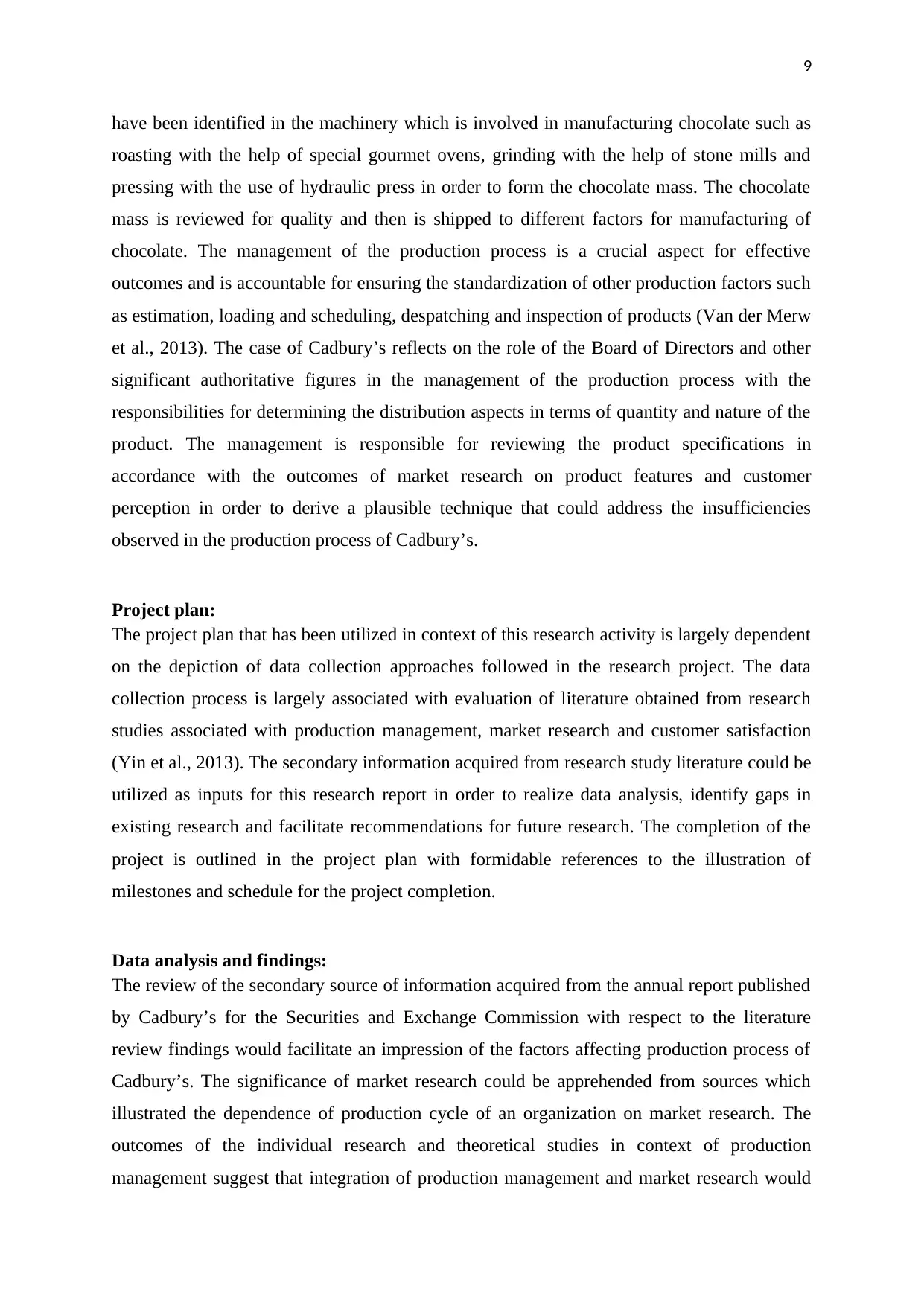
9
have been identified in the machinery which is involved in manufacturing chocolate such as
roasting with the help of special gourmet ovens, grinding with the help of stone mills and
pressing with the use of hydraulic press in order to form the chocolate mass. The chocolate
mass is reviewed for quality and then is shipped to different factors for manufacturing of
chocolate. The management of the production process is a crucial aspect for effective
outcomes and is accountable for ensuring the standardization of other production factors such
as estimation, loading and scheduling, despatching and inspection of products (Van der Merw
et al., 2013). The case of Cadbury’s reflects on the role of the Board of Directors and other
significant authoritative figures in the management of the production process with the
responsibilities for determining the distribution aspects in terms of quantity and nature of the
product. The management is responsible for reviewing the product specifications in
accordance with the outcomes of market research on product features and customer
perception in order to derive a plausible technique that could address the insufficiencies
observed in the production process of Cadbury’s.
Project plan:
The project plan that has been utilized in context of this research activity is largely dependent
on the depiction of data collection approaches followed in the research project. The data
collection process is largely associated with evaluation of literature obtained from research
studies associated with production management, market research and customer satisfaction
(Yin et al., 2013). The secondary information acquired from research study literature could be
utilized as inputs for this research report in order to realize data analysis, identify gaps in
existing research and facilitate recommendations for future research. The completion of the
project is outlined in the project plan with formidable references to the illustration of
milestones and schedule for the project completion.
Data analysis and findings:
The review of the secondary source of information acquired from the annual report published
by Cadbury’s for the Securities and Exchange Commission with respect to the literature
review findings would facilitate an impression of the factors affecting production process of
Cadbury’s. The significance of market research could be apprehended from sources which
illustrated the dependence of production cycle of an organization on market research. The
outcomes of the individual research and theoretical studies in context of production
management suggest that integration of production management and market research would
have been identified in the machinery which is involved in manufacturing chocolate such as
roasting with the help of special gourmet ovens, grinding with the help of stone mills and
pressing with the use of hydraulic press in order to form the chocolate mass. The chocolate
mass is reviewed for quality and then is shipped to different factors for manufacturing of
chocolate. The management of the production process is a crucial aspect for effective
outcomes and is accountable for ensuring the standardization of other production factors such
as estimation, loading and scheduling, despatching and inspection of products (Van der Merw
et al., 2013). The case of Cadbury’s reflects on the role of the Board of Directors and other
significant authoritative figures in the management of the production process with the
responsibilities for determining the distribution aspects in terms of quantity and nature of the
product. The management is responsible for reviewing the product specifications in
accordance with the outcomes of market research on product features and customer
perception in order to derive a plausible technique that could address the insufficiencies
observed in the production process of Cadbury’s.
Project plan:
The project plan that has been utilized in context of this research activity is largely dependent
on the depiction of data collection approaches followed in the research project. The data
collection process is largely associated with evaluation of literature obtained from research
studies associated with production management, market research and customer satisfaction
(Yin et al., 2013). The secondary information acquired from research study literature could be
utilized as inputs for this research report in order to realize data analysis, identify gaps in
existing research and facilitate recommendations for future research. The completion of the
project is outlined in the project plan with formidable references to the illustration of
milestones and schedule for the project completion.
Data analysis and findings:
The review of the secondary source of information acquired from the annual report published
by Cadbury’s for the Securities and Exchange Commission with respect to the literature
review findings would facilitate an impression of the factors affecting production process of
Cadbury’s. The significance of market research could be apprehended from sources which
illustrated the dependence of production cycle of an organization on market research. The
outcomes of the individual research and theoretical studies in context of production
management suggest that integration of production management and market research would
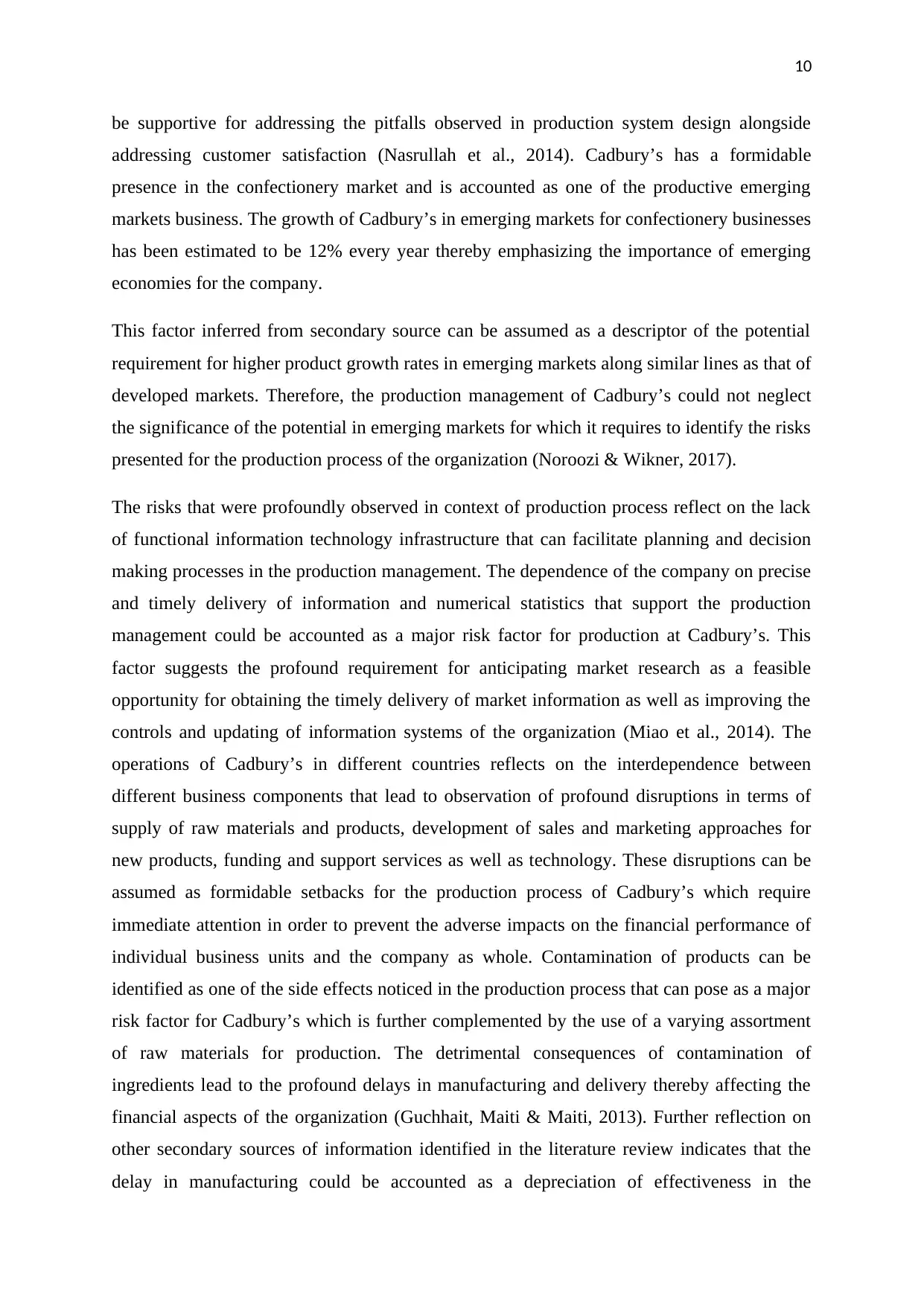
10
be supportive for addressing the pitfalls observed in production system design alongside
addressing customer satisfaction (Nasrullah et al., 2014). Cadbury’s has a formidable
presence in the confectionery market and is accounted as one of the productive emerging
markets business. The growth of Cadbury’s in emerging markets for confectionery businesses
has been estimated to be 12% every year thereby emphasizing the importance of emerging
economies for the company.
This factor inferred from secondary source can be assumed as a descriptor of the potential
requirement for higher product growth rates in emerging markets along similar lines as that of
developed markets. Therefore, the production management of Cadbury’s could not neglect
the significance of the potential in emerging markets for which it requires to identify the risks
presented for the production process of the organization (Noroozi & Wikner, 2017).
The risks that were profoundly observed in context of production process reflect on the lack
of functional information technology infrastructure that can facilitate planning and decision
making processes in the production management. The dependence of the company on precise
and timely delivery of information and numerical statistics that support the production
management could be accounted as a major risk factor for production at Cadbury’s. This
factor suggests the profound requirement for anticipating market research as a feasible
opportunity for obtaining the timely delivery of market information as well as improving the
controls and updating of information systems of the organization (Miao et al., 2014). The
operations of Cadbury’s in different countries reflects on the interdependence between
different business components that lead to observation of profound disruptions in terms of
supply of raw materials and products, development of sales and marketing approaches for
new products, funding and support services as well as technology. These disruptions can be
assumed as formidable setbacks for the production process of Cadbury’s which require
immediate attention in order to prevent the adverse impacts on the financial performance of
individual business units and the company as whole. Contamination of products can be
identified as one of the side effects noticed in the production process that can pose as a major
risk factor for Cadbury’s which is further complemented by the use of a varying assortment
of raw materials for production. The detrimental consequences of contamination of
ingredients lead to the profound delays in manufacturing and delivery thereby affecting the
financial aspects of the organization (Guchhait, Maiti & Maiti, 2013). Further reflection on
other secondary sources of information identified in the literature review indicates that the
delay in manufacturing could be accounted as a depreciation of effectiveness in the
be supportive for addressing the pitfalls observed in production system design alongside
addressing customer satisfaction (Nasrullah et al., 2014). Cadbury’s has a formidable
presence in the confectionery market and is accounted as one of the productive emerging
markets business. The growth of Cadbury’s in emerging markets for confectionery businesses
has been estimated to be 12% every year thereby emphasizing the importance of emerging
economies for the company.
This factor inferred from secondary source can be assumed as a descriptor of the potential
requirement for higher product growth rates in emerging markets along similar lines as that of
developed markets. Therefore, the production management of Cadbury’s could not neglect
the significance of the potential in emerging markets for which it requires to identify the risks
presented for the production process of the organization (Noroozi & Wikner, 2017).
The risks that were profoundly observed in context of production process reflect on the lack
of functional information technology infrastructure that can facilitate planning and decision
making processes in the production management. The dependence of the company on precise
and timely delivery of information and numerical statistics that support the production
management could be accounted as a major risk factor for production at Cadbury’s. This
factor suggests the profound requirement for anticipating market research as a feasible
opportunity for obtaining the timely delivery of market information as well as improving the
controls and updating of information systems of the organization (Miao et al., 2014). The
operations of Cadbury’s in different countries reflects on the interdependence between
different business components that lead to observation of profound disruptions in terms of
supply of raw materials and products, development of sales and marketing approaches for
new products, funding and support services as well as technology. These disruptions can be
assumed as formidable setbacks for the production process of Cadbury’s which require
immediate attention in order to prevent the adverse impacts on the financial performance of
individual business units and the company as whole. Contamination of products can be
identified as one of the side effects noticed in the production process that can pose as a major
risk factor for Cadbury’s which is further complemented by the use of a varying assortment
of raw materials for production. The detrimental consequences of contamination of
ingredients lead to the profound delays in manufacturing and delivery thereby affecting the
financial aspects of the organization (Guchhait, Maiti & Maiti, 2013). Further reflection on
other secondary sources of information identified in the literature review indicates that the
delay in manufacturing could be accounted as a depreciation of effectiveness in the
Secure Best Marks with AI Grader
Need help grading? Try our AI Grader for instant feedback on your assignments.
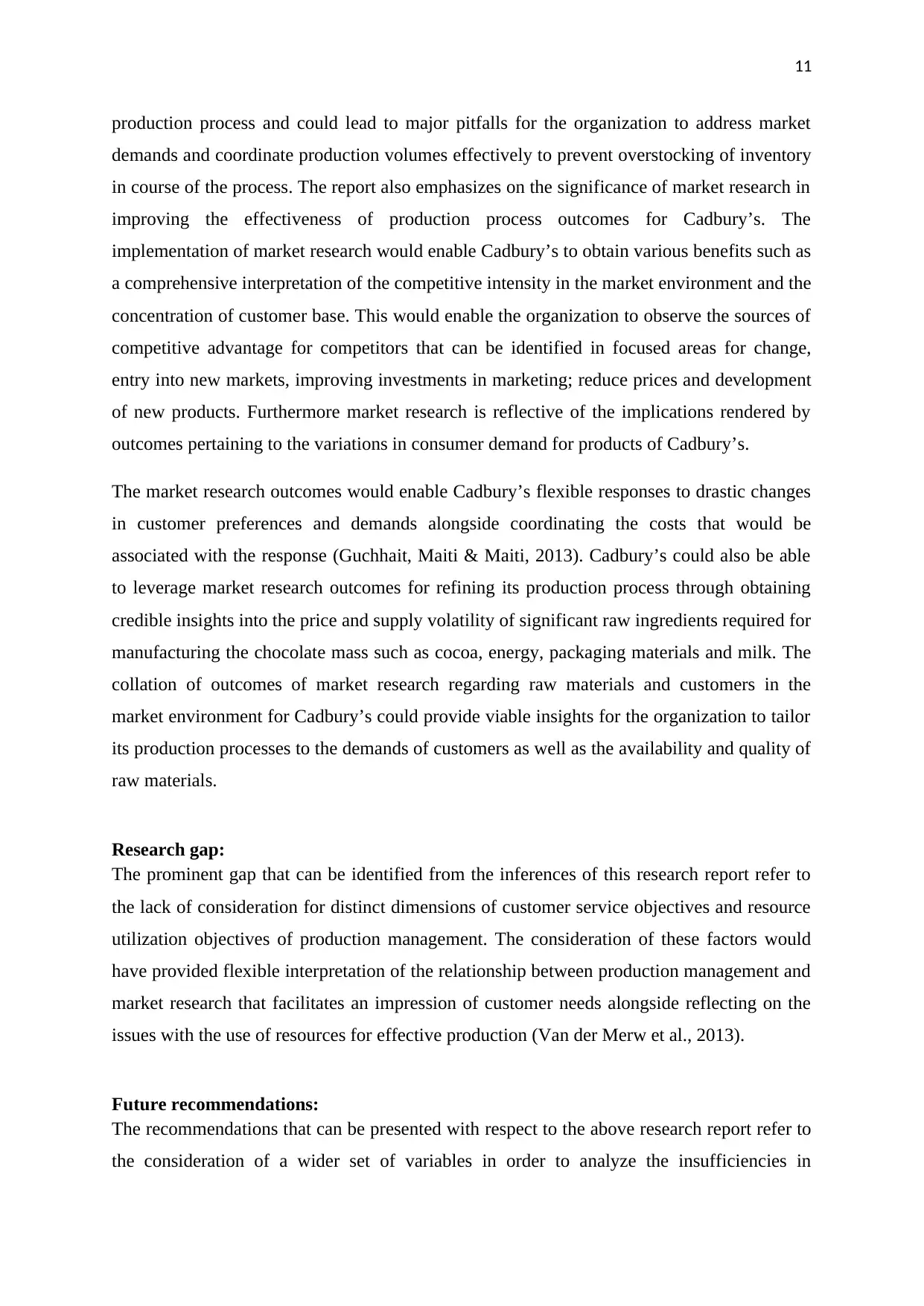
11
production process and could lead to major pitfalls for the organization to address market
demands and coordinate production volumes effectively to prevent overstocking of inventory
in course of the process. The report also emphasizes on the significance of market research in
improving the effectiveness of production process outcomes for Cadbury’s. The
implementation of market research would enable Cadbury’s to obtain various benefits such as
a comprehensive interpretation of the competitive intensity in the market environment and the
concentration of customer base. This would enable the organization to observe the sources of
competitive advantage for competitors that can be identified in focused areas for change,
entry into new markets, improving investments in marketing; reduce prices and development
of new products. Furthermore market research is reflective of the implications rendered by
outcomes pertaining to the variations in consumer demand for products of Cadbury’s.
The market research outcomes would enable Cadbury’s flexible responses to drastic changes
in customer preferences and demands alongside coordinating the costs that would be
associated with the response (Guchhait, Maiti & Maiti, 2013). Cadbury’s could also be able
to leverage market research outcomes for refining its production process through obtaining
credible insights into the price and supply volatility of significant raw ingredients required for
manufacturing the chocolate mass such as cocoa, energy, packaging materials and milk. The
collation of outcomes of market research regarding raw materials and customers in the
market environment for Cadbury’s could provide viable insights for the organization to tailor
its production processes to the demands of customers as well as the availability and quality of
raw materials.
Research gap:
The prominent gap that can be identified from the inferences of this research report refer to
the lack of consideration for distinct dimensions of customer service objectives and resource
utilization objectives of production management. The consideration of these factors would
have provided flexible interpretation of the relationship between production management and
market research that facilitates an impression of customer needs alongside reflecting on the
issues with the use of resources for effective production (Van der Merw et al., 2013).
Future recommendations:
The recommendations that can be presented with respect to the above research report refer to
the consideration of a wider set of variables in order to analyze the insufficiencies in
production process and could lead to major pitfalls for the organization to address market
demands and coordinate production volumes effectively to prevent overstocking of inventory
in course of the process. The report also emphasizes on the significance of market research in
improving the effectiveness of production process outcomes for Cadbury’s. The
implementation of market research would enable Cadbury’s to obtain various benefits such as
a comprehensive interpretation of the competitive intensity in the market environment and the
concentration of customer base. This would enable the organization to observe the sources of
competitive advantage for competitors that can be identified in focused areas for change,
entry into new markets, improving investments in marketing; reduce prices and development
of new products. Furthermore market research is reflective of the implications rendered by
outcomes pertaining to the variations in consumer demand for products of Cadbury’s.
The market research outcomes would enable Cadbury’s flexible responses to drastic changes
in customer preferences and demands alongside coordinating the costs that would be
associated with the response (Guchhait, Maiti & Maiti, 2013). Cadbury’s could also be able
to leverage market research outcomes for refining its production process through obtaining
credible insights into the price and supply volatility of significant raw ingredients required for
manufacturing the chocolate mass such as cocoa, energy, packaging materials and milk. The
collation of outcomes of market research regarding raw materials and customers in the
market environment for Cadbury’s could provide viable insights for the organization to tailor
its production processes to the demands of customers as well as the availability and quality of
raw materials.
Research gap:
The prominent gap that can be identified from the inferences of this research report refer to
the lack of consideration for distinct dimensions of customer service objectives and resource
utilization objectives of production management. The consideration of these factors would
have provided flexible interpretation of the relationship between production management and
market research that facilitates an impression of customer needs alongside reflecting on the
issues with the use of resources for effective production (Van der Merw et al., 2013).
Future recommendations:
The recommendations that can be presented with respect to the above research report refer to
the consideration of a wider set of variables in order to analyze the insufficiencies in
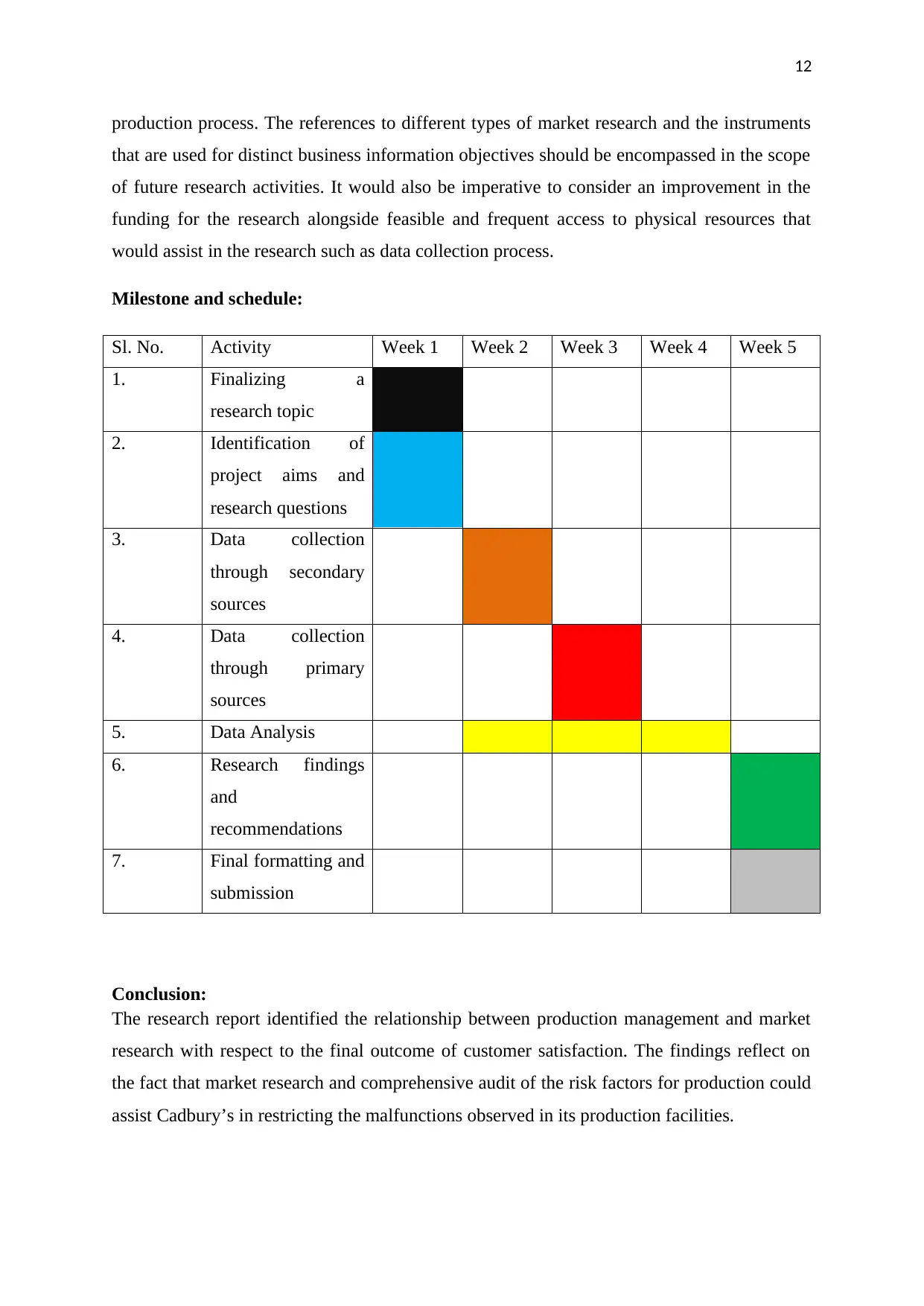
12
production process. The references to different types of market research and the instruments
that are used for distinct business information objectives should be encompassed in the scope
of future research activities. It would also be imperative to consider an improvement in the
funding for the research alongside feasible and frequent access to physical resources that
would assist in the research such as data collection process.
Milestone and schedule:
Sl. No. Activity Week 1 Week 2 Week 3 Week 4 Week 5
1. Finalizing a
research topic
2. Identification of
project aims and
research questions
3. Data collection
through secondary
sources
4. Data collection
through primary
sources
5. Data Analysis
6. Research findings
and
recommendations
7. Final formatting and
submission
Conclusion:
The research report identified the relationship between production management and market
research with respect to the final outcome of customer satisfaction. The findings reflect on
the fact that market research and comprehensive audit of the risk factors for production could
assist Cadbury’s in restricting the malfunctions observed in its production facilities.
production process. The references to different types of market research and the instruments
that are used for distinct business information objectives should be encompassed in the scope
of future research activities. It would also be imperative to consider an improvement in the
funding for the research alongside feasible and frequent access to physical resources that
would assist in the research such as data collection process.
Milestone and schedule:
Sl. No. Activity Week 1 Week 2 Week 3 Week 4 Week 5
1. Finalizing a
research topic
2. Identification of
project aims and
research questions
3. Data collection
through secondary
sources
4. Data collection
through primary
sources
5. Data Analysis
6. Research findings
and
recommendations
7. Final formatting and
submission
Conclusion:
The research report identified the relationship between production management and market
research with respect to the final outcome of customer satisfaction. The findings reflect on
the fact that market research and comprehensive audit of the risk factors for production could
assist Cadbury’s in restricting the malfunctions observed in its production facilities.
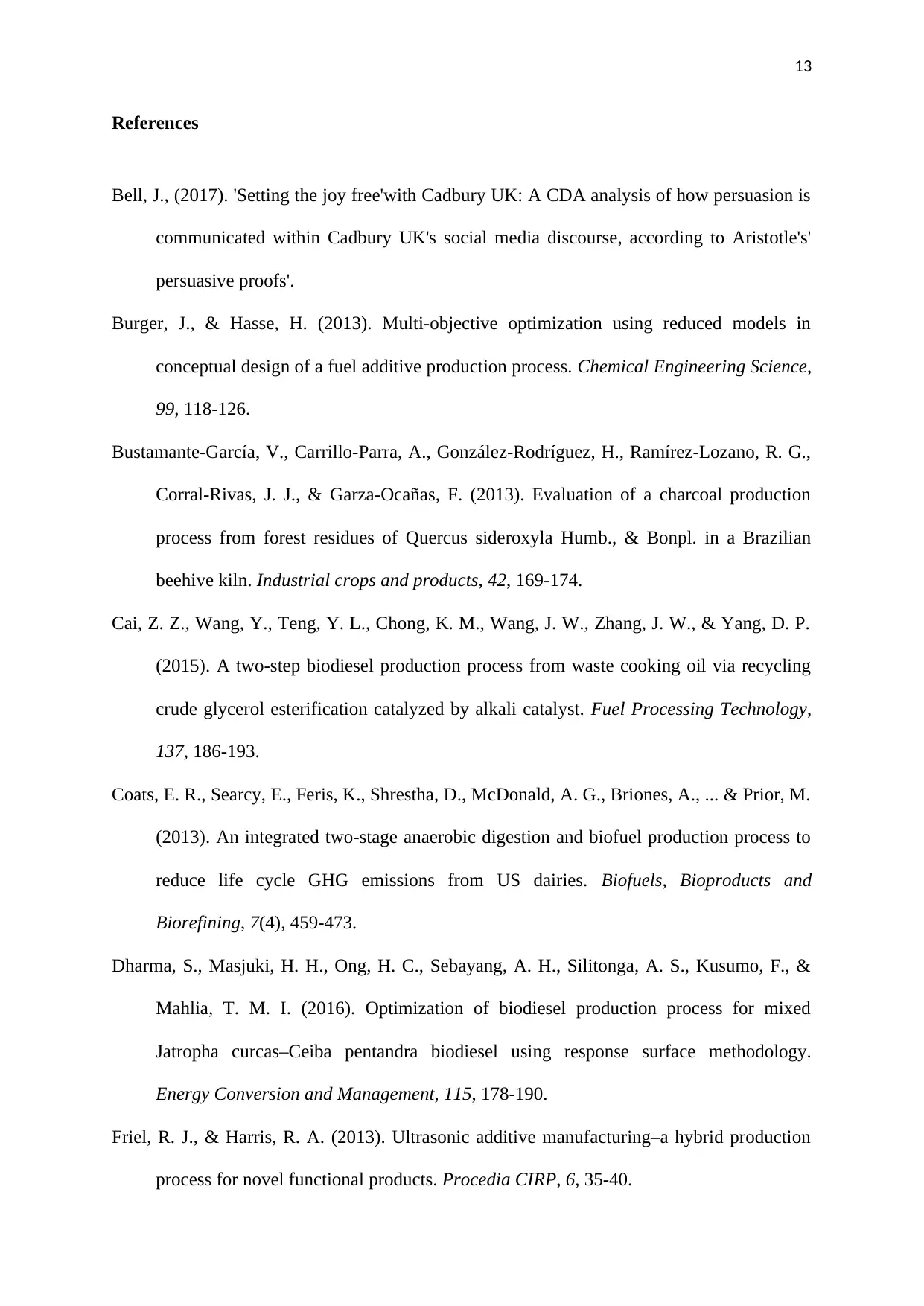
13
References
Bell, J., (2017). 'Setting the joy free'with Cadbury UK: A CDA analysis of how persuasion is
communicated within Cadbury UK's social media discourse, according to Aristotle's'
persuasive proofs'.
Burger, J., & Hasse, H. (2013). Multi-objective optimization using reduced models in
conceptual design of a fuel additive production process. Chemical Engineering Science,
99, 118-126.
Bustamante-García, V., Carrillo-Parra, A., González-Rodríguez, H., Ramírez-Lozano, R. G.,
Corral-Rivas, J. J., & Garza-Ocañas, F. (2013). Evaluation of a charcoal production
process from forest residues of Quercus sideroxyla Humb., & Bonpl. in a Brazilian
beehive kiln. Industrial crops and products, 42, 169-174.
Cai, Z. Z., Wang, Y., Teng, Y. L., Chong, K. M., Wang, J. W., Zhang, J. W., & Yang, D. P.
(2015). A two-step biodiesel production process from waste cooking oil via recycling
crude glycerol esterification catalyzed by alkali catalyst. Fuel Processing Technology,
137, 186-193.
Coats, E. R., Searcy, E., Feris, K., Shrestha, D., McDonald, A. G., Briones, A., ... & Prior, M.
(2013). An integrated two‐stage anaerobic digestion and biofuel production process to
reduce life cycle GHG emissions from US dairies. Biofuels, Bioproducts and
Biorefining, 7(4), 459-473.
Dharma, S., Masjuki, H. H., Ong, H. C., Sebayang, A. H., Silitonga, A. S., Kusumo, F., &
Mahlia, T. M. I. (2016). Optimization of biodiesel production process for mixed
Jatropha curcas–Ceiba pentandra biodiesel using response surface methodology.
Energy Conversion and Management, 115, 178-190.
Friel, R. J., & Harris, R. A. (2013). Ultrasonic additive manufacturing–a hybrid production
process for novel functional products. Procedia CIRP, 6, 35-40.
References
Bell, J., (2017). 'Setting the joy free'with Cadbury UK: A CDA analysis of how persuasion is
communicated within Cadbury UK's social media discourse, according to Aristotle's'
persuasive proofs'.
Burger, J., & Hasse, H. (2013). Multi-objective optimization using reduced models in
conceptual design of a fuel additive production process. Chemical Engineering Science,
99, 118-126.
Bustamante-García, V., Carrillo-Parra, A., González-Rodríguez, H., Ramírez-Lozano, R. G.,
Corral-Rivas, J. J., & Garza-Ocañas, F. (2013). Evaluation of a charcoal production
process from forest residues of Quercus sideroxyla Humb., & Bonpl. in a Brazilian
beehive kiln. Industrial crops and products, 42, 169-174.
Cai, Z. Z., Wang, Y., Teng, Y. L., Chong, K. M., Wang, J. W., Zhang, J. W., & Yang, D. P.
(2015). A two-step biodiesel production process from waste cooking oil via recycling
crude glycerol esterification catalyzed by alkali catalyst. Fuel Processing Technology,
137, 186-193.
Coats, E. R., Searcy, E., Feris, K., Shrestha, D., McDonald, A. G., Briones, A., ... & Prior, M.
(2013). An integrated two‐stage anaerobic digestion and biofuel production process to
reduce life cycle GHG emissions from US dairies. Biofuels, Bioproducts and
Biorefining, 7(4), 459-473.
Dharma, S., Masjuki, H. H., Ong, H. C., Sebayang, A. H., Silitonga, A. S., Kusumo, F., &
Mahlia, T. M. I. (2016). Optimization of biodiesel production process for mixed
Jatropha curcas–Ceiba pentandra biodiesel using response surface methodology.
Energy Conversion and Management, 115, 178-190.
Friel, R. J., & Harris, R. A. (2013). Ultrasonic additive manufacturing–a hybrid production
process for novel functional products. Procedia CIRP, 6, 35-40.
Paraphrase This Document
Need a fresh take? Get an instant paraphrase of this document with our AI Paraphraser
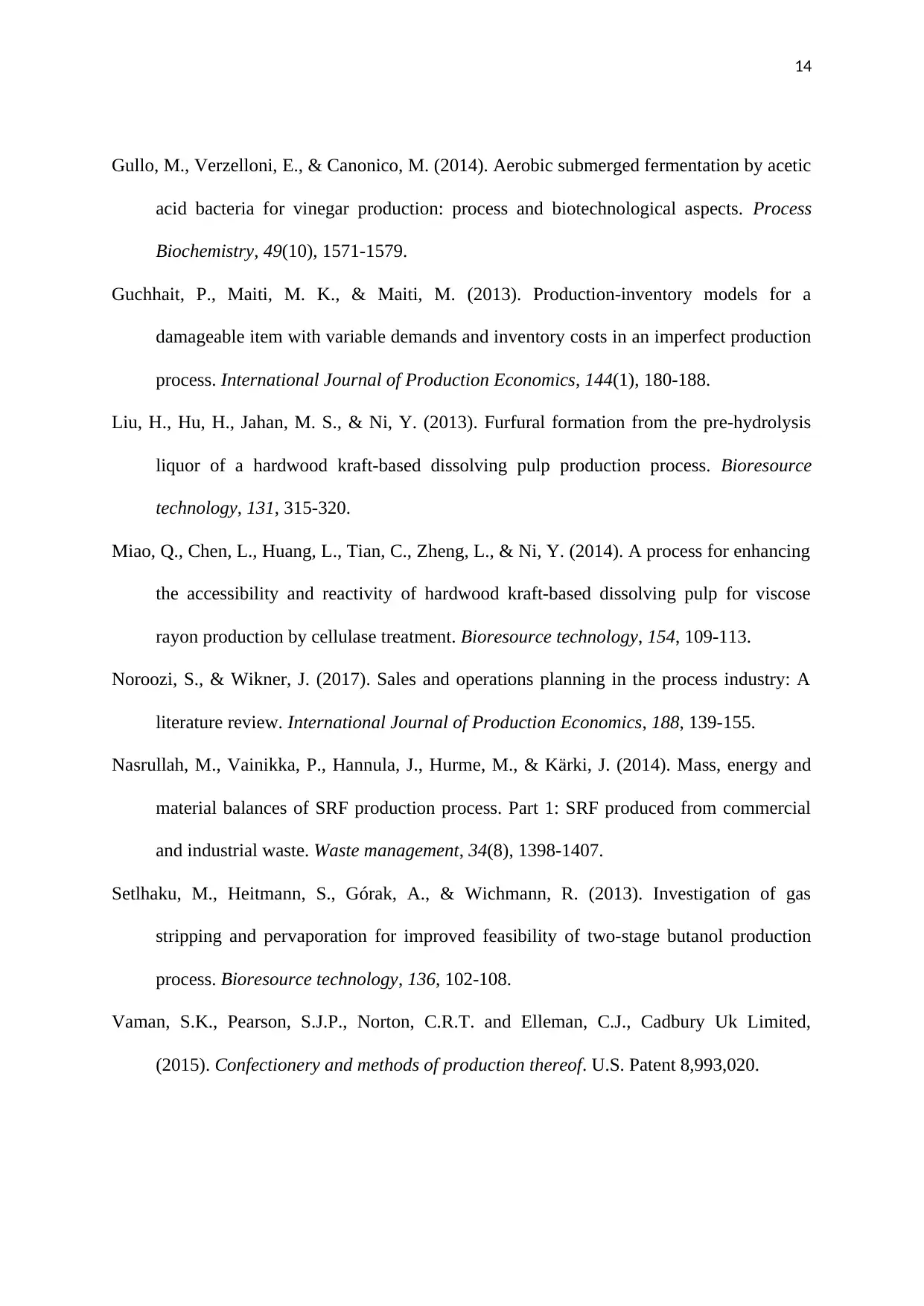
14
Gullo, M., Verzelloni, E., & Canonico, M. (2014). Aerobic submerged fermentation by acetic
acid bacteria for vinegar production: process and biotechnological aspects. Process
Biochemistry, 49(10), 1571-1579.
Guchhait, P., Maiti, M. K., & Maiti, M. (2013). Production-inventory models for a
damageable item with variable demands and inventory costs in an imperfect production
process. International Journal of Production Economics, 144(1), 180-188.
Liu, H., Hu, H., Jahan, M. S., & Ni, Y. (2013). Furfural formation from the pre-hydrolysis
liquor of a hardwood kraft-based dissolving pulp production process. Bioresource
technology, 131, 315-320.
Miao, Q., Chen, L., Huang, L., Tian, C., Zheng, L., & Ni, Y. (2014). A process for enhancing
the accessibility and reactivity of hardwood kraft-based dissolving pulp for viscose
rayon production by cellulase treatment. Bioresource technology, 154, 109-113.
Noroozi, S., & Wikner, J. (2017). Sales and operations planning in the process industry: A
literature review. International Journal of Production Economics, 188, 139-155.
Nasrullah, M., Vainikka, P., Hannula, J., Hurme, M., & Kärki, J. (2014). Mass, energy and
material balances of SRF production process. Part 1: SRF produced from commercial
and industrial waste. Waste management, 34(8), 1398-1407.
Setlhaku, M., Heitmann, S., Górak, A., & Wichmann, R. (2013). Investigation of gas
stripping and pervaporation for improved feasibility of two-stage butanol production
process. Bioresource technology, 136, 102-108.
Vaman, S.K., Pearson, S.J.P., Norton, C.R.T. and Elleman, C.J., Cadbury Uk Limited,
(2015). Confectionery and methods of production thereof. U.S. Patent 8,993,020.
Gullo, M., Verzelloni, E., & Canonico, M. (2014). Aerobic submerged fermentation by acetic
acid bacteria for vinegar production: process and biotechnological aspects. Process
Biochemistry, 49(10), 1571-1579.
Guchhait, P., Maiti, M. K., & Maiti, M. (2013). Production-inventory models for a
damageable item with variable demands and inventory costs in an imperfect production
process. International Journal of Production Economics, 144(1), 180-188.
Liu, H., Hu, H., Jahan, M. S., & Ni, Y. (2013). Furfural formation from the pre-hydrolysis
liquor of a hardwood kraft-based dissolving pulp production process. Bioresource
technology, 131, 315-320.
Miao, Q., Chen, L., Huang, L., Tian, C., Zheng, L., & Ni, Y. (2014). A process for enhancing
the accessibility and reactivity of hardwood kraft-based dissolving pulp for viscose
rayon production by cellulase treatment. Bioresource technology, 154, 109-113.
Noroozi, S., & Wikner, J. (2017). Sales and operations planning in the process industry: A
literature review. International Journal of Production Economics, 188, 139-155.
Nasrullah, M., Vainikka, P., Hannula, J., Hurme, M., & Kärki, J. (2014). Mass, energy and
material balances of SRF production process. Part 1: SRF produced from commercial
and industrial waste. Waste management, 34(8), 1398-1407.
Setlhaku, M., Heitmann, S., Górak, A., & Wichmann, R. (2013). Investigation of gas
stripping and pervaporation for improved feasibility of two-stage butanol production
process. Bioresource technology, 136, 102-108.
Vaman, S.K., Pearson, S.J.P., Norton, C.R.T. and Elleman, C.J., Cadbury Uk Limited,
(2015). Confectionery and methods of production thereof. U.S. Patent 8,993,020.
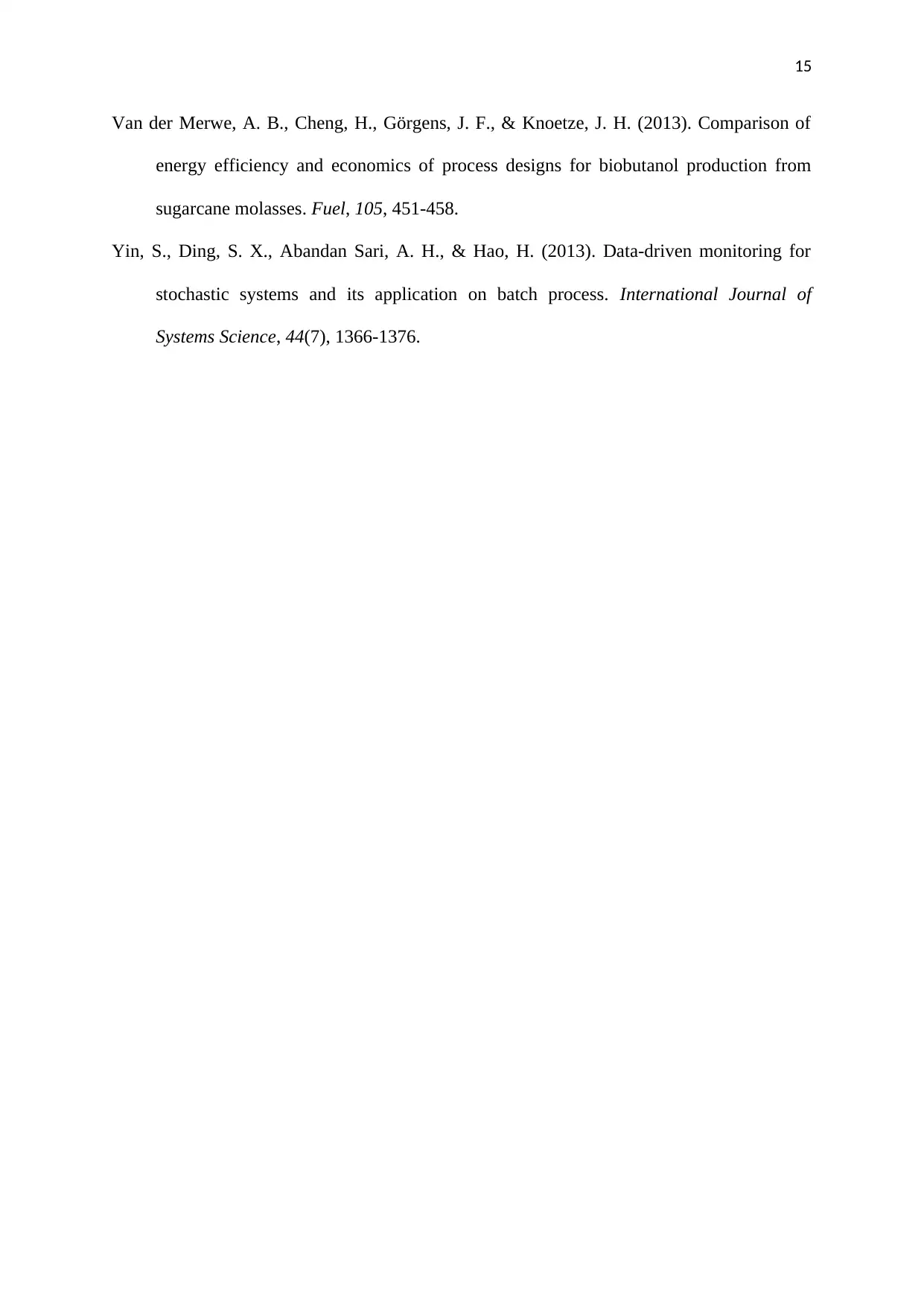
15
Van der Merwe, A. B., Cheng, H., Görgens, J. F., & Knoetze, J. H. (2013). Comparison of
energy efficiency and economics of process designs for biobutanol production from
sugarcane molasses. Fuel, 105, 451-458.
Yin, S., Ding, S. X., Abandan Sari, A. H., & Hao, H. (2013). Data-driven monitoring for
stochastic systems and its application on batch process. International Journal of
Systems Science, 44(7), 1366-1376.
Van der Merwe, A. B., Cheng, H., Görgens, J. F., & Knoetze, J. H. (2013). Comparison of
energy efficiency and economics of process designs for biobutanol production from
sugarcane molasses. Fuel, 105, 451-458.
Yin, S., Ding, S. X., Abandan Sari, A. H., & Hao, H. (2013). Data-driven monitoring for
stochastic systems and its application on batch process. International Journal of
Systems Science, 44(7), 1366-1376.
1 out of 15
Related Documents
Your All-in-One AI-Powered Toolkit for Academic Success.
+13062052269
info@desklib.com
Available 24*7 on WhatsApp / Email
![[object Object]](/_next/static/media/star-bottom.7253800d.svg)
Unlock your academic potential
© 2024 | Zucol Services PVT LTD | All rights reserved.





